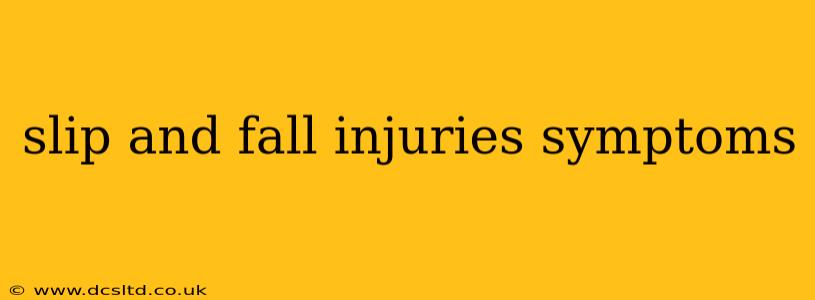Slip and fall accidents are a common cause of injury, affecting people of all ages. Understanding the potential symptoms, seeking appropriate treatment, and implementing preventative measures are crucial for minimizing the impact of these incidents. This comprehensive guide explores the various aspects of slip and fall injuries, offering valuable insights for improved safety and recovery.
What are the Common Symptoms of a Slip and Fall Injury?
The symptoms of a slip and fall injury vary greatly depending on the severity and location of the impact. Some injuries are minor and resolve quickly, while others can lead to long-term complications. Common symptoms include:
- Pain: This is the most prevalent symptom, ranging from mild discomfort to excruciating pain. The pain may be localized to the area of impact or radiate to other parts of the body.
- Bruises (Contusions): These are common, appearing as discoloration of the skin. The severity of bruising depends on the force of the impact.
- Swelling: Inflammation and swelling are typical responses to injury, often accompanied by pain and tenderness.
- Stiffness and Limited Range of Motion: Difficulty moving the affected area or experiencing stiffness is a common symptom, particularly in joints.
- Headache: Falls, especially those involving head trauma, can cause headaches, dizziness, and even loss of consciousness.
- Nausea and Vomiting: These symptoms may indicate a more serious injury, such as a concussion or internal bleeding.
- Numbness or Tingling: This can be a sign of nerve damage or compression.
- Fractures: Broken bones are a serious complication, requiring immediate medical attention. Symptoms include intense pain, deformity of the limb, and inability to bear weight.
- Dislocations: A joint dislocation occurs when the bones that form a joint are forced out of their normal alignment. This is usually accompanied by severe pain, swelling, and deformity.
What if I experienced a head injury after a slip and fall?
Head injuries following a fall can range from mild to severe. Always seek immediate medical attention if you experience any of the following after a fall:
- Loss of consciousness: Even a brief loss of consciousness requires evaluation by a medical professional.
- Severe headache: A persistent and intense headache is a warning sign.
- Confusion or disorientation: Difficulty remembering the event or feeling confused warrants immediate medical attention.
- Nausea and vomiting: These symptoms can indicate a more serious head injury.
- Seizures: Seizures are a serious complication of head trauma.
- Vision changes: Blurred vision, double vision, or other visual disturbances require prompt medical evaluation.
- Bleeding from the ears or nose: This is a serious symptom and requires emergency medical assistance.
How long do symptoms from a slip and fall last?
The duration of symptoms depends entirely on the severity of the injury. Minor bruises and sprains may heal within a few days to weeks, while fractures or other significant injuries may require months or even years of recovery. Severe injuries may result in permanent disability. Consistent follow-up with a medical professional is essential to monitor progress and address any complications.
What should I do if I fall and hurt myself?
Following a fall, prioritize safety and seek appropriate medical care.
- Assess the situation: Check for any immediate life-threatening injuries.
- Call for help: If you are unable to move or suspect a serious injury, call emergency services immediately.
- Stay still: Avoid unnecessary movement until help arrives, as this can worsen the injury.
- Seek medical attention: Even if the injury seems minor, it is essential to get it checked by a medical professional to rule out any underlying problems.
What are some ways to prevent slip and fall accidents?
Preventing slip and fall accidents is crucial to safeguard your well-being. Here are some simple yet effective measures:
- Clear walkways: Remove clutter, spills, and obstacles from walkways.
- Proper lighting: Ensure adequate lighting in all areas, especially hallways and stairs.
- Wear appropriate footwear: Avoid wearing shoes with slippery soles.
- Use assistive devices: Consider using canes, walkers, or other assistive devices if needed.
- Improve home safety: Install handrails on stairs, ramps, and bathtubs. Use non-slip mats in bathrooms and kitchens.
By understanding the potential symptoms, seeking appropriate medical attention, and implementing preventative measures, you can significantly reduce the risk and impact of slip and fall injuries. Remember, prevention is always the best approach.
